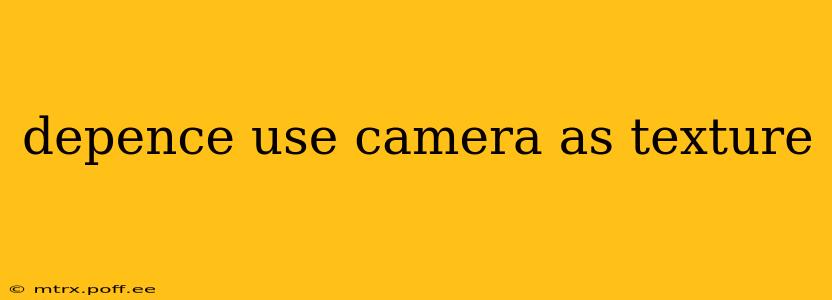Using Camera Images as Textures in 3D Modeling and Game Development
Creating realistic and engaging 3D models and game environments often requires high-quality textures. While pre-made textures are readily available, using your own photographs as textures offers a unique level of realism and customization. This guide explores the process of using camera images as textures, addressing common questions and challenges along the way.
What are the benefits of using camera images as textures?
The primary advantage is unparalleled realism. A photograph captures the intricate details, imperfections, and nuances of real-world surfaces that are often difficult to replicate artificially. This results in more believable and immersive 3D models and game environments. Furthermore, using your own photos allows for complete creative control and the ability to incorporate unique and personalized textures that aren't available commercially. Imagine using a picture of your own weathered brick wall, a detailed close-up of tree bark, or a stunning landscape shot – the possibilities are limitless.
How do I prepare my photos for use as textures?
Image preparation is crucial for successful texture mapping. Poorly prepared images can lead to blurry textures, color distortions, and other visual artifacts. Here's a step-by-step guide:
-
High Resolution is Key: Use a camera capable of capturing high-resolution images. The larger the image, the more detail will be preserved in your texture. Aim for at least 2048x2048 pixels, but higher resolutions are always preferable.
-
Lighting and Composition: Consider lighting conditions when taking your photos. Even lighting will usually yield the best results. Avoid harsh shadows or extreme contrast that might cause issues in the 3D application. Compose your shot carefully to ensure the desired area is well-captured and free of unwanted elements.
-
Correcting Perspective and Distortion: If your photo has significant perspective distortion (e.g., lens distortion), correct this in photo editing software like Photoshop or GIMP before using it as a texture. This step helps prevent unnatural stretching or warping of the texture on your 3D model.
-
Color Correction and Adjustment: Fine-tune the colors and contrast of your image to match the overall aesthetic of your 3D project. You can also perform adjustments like increasing sharpness or reducing noise to improve texture quality.
-
File Format: Save your image in a suitable format like PNG (supports transparency) or TIFF (high quality, lossless compression). Avoid JPEG compression, as it can introduce artifacts, especially with highly detailed images.
What software can I use to apply camera images as textures?
Many 3D modeling and game development programs support texture mapping. Popular choices include:
- Blender: A free and open-source 3D creation suite with robust texture mapping capabilities.
- 3ds Max: A professional-grade 3D modeling and animation software.
- Maya: Another industry-standard 3D software package.
- Unreal Engine: A powerful real-time 3D creation tool used extensively in game development.
- Unity: A widely used game engine with a strong community and ample resources for texture creation.
The specific steps for applying textures vary depending on the software you use, but the general principle remains the same: you'll typically import your image file and assign it to the desired surface of your 3D model.
How do I achieve seamless tiling with my camera textures?
Seamless tiling is essential when applying textures that need to repeat across a large surface. Perfectly aligning repeating sections of the texture can be challenging with photos. Here are some strategies:
- Careful Photographing: When capturing the source image, try to ensure the edges of the photo will blend seamlessly if repeated.
- Photo Editing Techniques: Use your photo editing software to create a seamless tile by carefully blending edges or using cloning tools.
- Texture Editing Software: Specialized software like Substance Painter can help in creating seamless tiles from source images.
What are some common problems when using camera images as textures and how to fix them?
- Blurry Textures: This usually results from low-resolution source images. Always use high-resolution photos.
- Color Mismatch: Adjust colors and contrast in your photo editor to ensure a consistent look.
- Seamless Tiling Issues: Use the techniques mentioned above to create seamless tiles.
- UV Mapping Problems: Incorrect UV mapping can result in distorted textures. Ensure proper UV unwrapping in your 3D software.
By following these guidelines and mastering the techniques described, you can significantly enhance the realism and visual appeal of your 3D projects using the power of photography. Remember, practice and experimentation are key to mastering this process.
